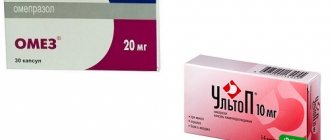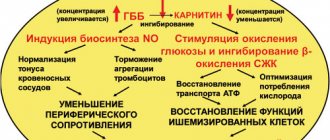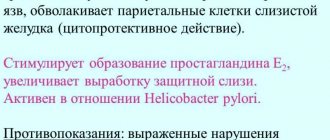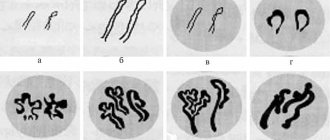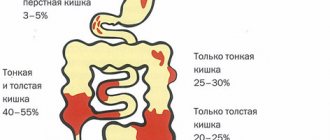Proposals from manufacturers and suppliers, descriptions from the “Encyclopedia of Medicines” for the drugs mentioned in the article:
- metoclopramide - domperidone - cisapride - erythromycin Widespread introduction into clinical practice of modern methods for studying the motor function of the gastrointestinal tract has opened up new perspectives in the understanding and rational treatment of a number of diseases associated with dyskinesias of the gastrointestinal tract, such as gastroesophageal reflux disease (GERD), functional dyspepsia, irritable bowel syndrome, etc.
In recent years, a new group of medications has emerged—prokinetics—that can correct motility disorders of the digestive tract. These include a group of pharmacological drugs that, at different levels and using different mechanisms, enhance the motor, especially propulsive, activity of the gastrointestinal tract.
The endpoints of the mechanisms of action of drugs acting on the motility of the gastrointestinal tract are the blockade of ion transport, or the effect on the metabolism of acetylcholine at the synapses of nerve fibers. Clinical effects are achieved through:
- stimulation of the formation of acetylcholine molecules in the nerve terminal (increasing the release of acetylcholine into the synaptic space);
- stimulation of cholinesterase activity (reducing the number of acetylcholine molecules in the synaptic space);
- reducing the production of acetylcholine molecules in the nerve terminal.
The main classes of receptors involved in the regulation of motor-evacuation function of the gastrointestinal tract are cholinergic, adrenergic, dopaminergic, serotonin, motilin, cholecystokinin.
Prokinetics include drugs with different mechanisms of action (Table 1). The pharmacological effect of betanekol, an acetylcholine analogue, metoclopramide (Cerucal, Reglan) is due to direct interaction with muscarinic cell receptors. Another mechanism of action shared by metoclopramide, clebopride, levosulpiride and domperidone is antagonism of dopamine (D-2) cell receptors. Metoclopramide and cisapride (Coordinax) have a direct stimulating effect on the release of acetylcholine. Coordinax also interacts with serotonin receptors of the cell - it has antagonism to 5-HT-3 and agonism to 5-HT-4 receptors.
Table 1. Mechanisms of action of prokinetic agents (not shown in the online version)
If we compare the pharmacological activity of betanekol, Metoclopramide and Coordinax, several features are revealed that are important for the clinician. Coordinax more energetically ensures the evacuation of a food bolus from the stomach, stimulates intestinal peristalsis to a greater extent and, unlike betanekol, stimulates antroduodenal coordination, i.e. synchronization of the motility of the stomach and duodenum, necessary in order to move from the phase of gastric digestion to the phase digestion in the duodenum. Moreover, the concentration of Coordinax at which these effects occur is lower than the concentration of bethanecol or metoclopramide.
Table 2. Comparative assessment of some pharmacological features of prokinetics (not shown in the online version)
Comparing the clinical effects of various prokinetics (Table 2), it should be noted that levosulpiridine, Cerucal and Motilium have an antiemetic effect. When assessing the effect of drugs on intestinal motility, it should be taken into account that activity in the proximal part of the intestine is inherent in all drugs. While Coordinax, Erythromycin and loxiglumide have prokinetic activity throughout the intestine.
Metoclopramide penetrates the blood-brain barrier, which causes various side effects, such as headache, fatigue, impotence, gynecomastia, extrapyramidal disorders, etc. When using Coordinax, Erythromycin and loxiglumide, adverse effects are rarely observed. However, when prescribing Coordinax, it must be remembered that the drug is prescribed with caution to elderly patients and persons with cardiac arrhythmias and intraventricular conduction disorders.
The physiological effects of prokinetics are:
- increased tone of the lower esophageal sphincter;
- increasing the evacuation function of the stomach;
- normalization of the phase relationship of the migrating motor complex;
- increased antroduodenal coordination;
- increasing productive intestinal motility;
- increased contractility of the gallbladder.
It is important to consider that from the heterogeneous group of prokinetic drugs, only domperidone (Motilium), cisapride (Coordinax, Peristil) and metoclopramide (Cerucal) are currently available and used in clinical practice in Russia. The most widely used are Motilium and Coordinax. The drug metoclopramide is prescribed much less frequently due to its side effects and lower effectiveness compared to Motilium.
Indications for the use of prokinetic drugs are diseases of the upper digestive tract with a primary impairment of motor function - this is, first of all, widespread gastroesophageal reflux disease. Prokinetics are considered drugs for the pathogenetic treatment of GERD. This is due to the fact that they eliminate the immediate cause of gastroesophageal reflux - esophageal dysmotility, and increase the tone of the lower esophageal sphincter.
Many years of experience in using Motilium in clinical practice have shown its high effectiveness in the treatment of endoscopically negative gastroesophageal reflux disease and mild reflux esophagitis. Moreover, the drug is effective in 83% of cases when used as monotherapy and in 100% of cases when combined with antisecretory drugs. It is prescribed 10 mg 3 times a day 30 minutes before meals and 1 time at night.
The most effective prokinetic agent in the treatment of GERD is the gastrointestinal prokinetic agent Coordinax. Its effect is based on binding to 5-hydroxytryptamine receptors. It blocks 5-HT-3 receptors and stimulates 5-HT-4 receptors in presynaptic nerve endings, thereby having an indirect cholinergic effect on the neuromuscular apparatus of the entire gastrointestinal tract. It is also prescribed 1 tablet (10 mg) 3 times a day 30 minutes before meals and 1 time at night.
Coordinax is used as monotherapy both for the treatment of reflux esophagitis grades A-C according to the Los Angeles classification (1997), and in combination with antisecretory drugs for the treatment of severe degrees of the disease.
Motilium has proven itself in the treatment of functional (non-ulcer) dyspepsia. The use of Motilium for 2-4 weeks led to a significant improvement in the general condition, a decrease in pain in the epigastric region and dyspeptic disorders in 65-90% of patients.
Of course, one of the main reasons for prescribing this group of drugs is chronic gastritis, including its atrophic forms, which occur with symptoms of delayed gastric emptying. Prokinetics are also used in patients with idiopathic and diabetic gastroparesis, with gastroparesis that developed after vagotomy and gastrectomy, in patients with reflux gastritis, duodenogastric reflux after cholecystectomy. They are prescribed for gastrointestinal manifestations of systemic diseases such as scleroderma and amyloidosis.
Prokinetics are used for irritable bowel syndrome with constipation. Coordinax and Peristil are used, which enhance the propulsive activity of all parts of the digestive tube, including its distal parts. The use of Coordinax in a daily dose of 30 mg in patients with irritable bowel syndrome with a predominance of constipation contributed to an increase in the average frequency of stool from 1.5-2 times a week to 3.5-5 times a week and made it possible to reduce the use of laxatives by patients. The stimulating effect of Coordinax on colonic peristalsis, when prescribed in a dosage of 10 to 40 mg per day, is quite pronounced even in some cases of colonic atony.
Among other intestinal diseases, indications for the use of prokinetics include chronic intestinal pseudo-obstruction syndrome and postoperative intestinal obstruction.
An important indication for the use of prokinetics is vomiting during pregnancy or vomiting associated with chemotherapy for malignant diseases.
In diagnostic studies, prokinetics are widely used, in particular during enterography.
Among the drugs that will take their place among prokinetics in the near future, cholecystokinin receptor antagonists deserve attention first of all. Currently, the drug loxiglumide, a selective antagonist of CCK receptors, has been synthesized. When it is used in the esophagus, there is an increase in the motility index (propulsion), an increase in the rate of peristalsis, in the stomach - an increase in the rate of food evacuation, in the intestine - an increase in the motility index.
The action of another class of new prokinetics, motilin receptor agonists, is based on the effect of motilin on the motor activity of the digestive tract. The antibiotic Erythromycin mimics the effects of motilin, increasing pressure in the lower esophageal sphincter and increasing the rate of gastric emptying. Erythromycin and other (14-membered) macrolides competitively inhibit the binding of motilin to its receptors on GI smooth muscle and may act as motilin agonists. It has been established that high-density motilin receptors are present on the smooth muscles of the stomach, small and large intestine. Erythromycin increases the rate of gastric emptying in a number of pathological conditions, in particular gastroparesis in diabetics and patients with progressive systemic scleroderma, and reduces the transit time of intestinal contents in the proximal colon.
The next group of drugs are drugs that interact with 5-hydroxytryptamine (5-HT) receptors. The biological effects of 5-hydroxytryptamine are due to its interaction with specific receptors: 5-HT-1, 5-HT-2, 5-HT-3, 5-HT-4. One of the serotonin receptor modulators was the drug tropisetron. The drug lasts for a long period and significantly increases the pressure in the lower esophageal sphincter, accelerating the evacuation from the stomach. In the colon, it increases the duration of oral-cecal and colonic transit, reduces the tonic component of the gastrocolic response to food and normalizes the tone of the colon. Clinically, 5-HT3 receptor antagonists are effective in the treatment of patients with irritable bowel syndrome with dominant diarrhea.
Thus, currently, practicing doctors have a sufficient arsenal of modern prokinetic drugs for the rational treatment of dyskinesias of various parts of the gastrointestinal tract.
Literature
Ivashkin V.T., Trukhmanov A.S. Diseases of the esophagus. Pathological physiology, clinic, diagnosis, treatment. - M., 2000. - 184 p.
Pharmaceutical care when using Motilium
- It is advisable to take Motilium® before meals, since when taken after meals, the absorption of domperidone slows down.
- If discomfort does not go away within 2 weeks of constant use of Motilium, you should consult a doctor.
- If, during treatment with Motilium, nausea and vomiting continue for more than 48 hours, a doctor’s consultation is necessary.
- In patients with risk factors (hypokalemia, severe hypomagnesemia, organic heart disease, prolongation of the QT interval on the electrocardiogram, impaired liver and/or renal function), Motilium should be used with caution.
- Due to the risk of complications from the cardiovascular system (ventricular arrhythmias, sudden cardiac arrest in patients over 60 years of age when taking domperidone in doses above 30 mg/day), Motilium® should be used in the minimum effective dose (children, adults). At the same time, the risk/benefit ratio of domperidone remains at a favorable level.
- Do not use Motilium® tablets in patients with lactose intolerance, galactosemia and glucose-galactose malabsorption, since they contain lactose.
- During pregnancy, use Motilium® only if the expected positive effect for the mother exceeds the potential risk for the fetus.
- Breastfeeding should be discontinued during treatment with Motilium, as domperidone passes into breast milk.
- Motilium® can be used in children over 12 years of age and weighing 35 kg or more, using the minimum effective dose.
- When taking Motilium, you should be careful when driving a vehicle and operating machinery, as domperidone can cause side effects from the central nervous system.
- When Motilium is used in combination with anticholinergic drugs, the pharmacological effects of Motilium may be neutralized.
- With simultaneous use of Motilium and ketoconazole, the QT interval on the electrocardiogram, reflecting the process of contraction of the ventricles of the heart, may lengthen, so alternative antifungal therapy should be used.
- The combined use of domperidone with ketoconazole, fluconazole and other drugs that suppress the CYP 3A4 isoenzyme may provoke an increase in the concentration of domperidone in the blood plasma.
The listed pharmacological effects of domperidone, the features of its action, low toxicity, minimal side effects among prokinetics with a similar mechanism of action allow us to recommend Motilium® for fast and effective drug therapy for symptoms of gastrointestinal dysfunction (see Algorithm for choosing an OTC drug in a pharmacy for dyspeptic syndrome). Motilium® stops the main mechanism for the development of gastrointestinal dysfunction - a violation of the neurohumoral regulation of gastrointestinal functions - and eliminates the increased activity of aggressive factors that injure the gastrointestinal mucosa. Assisting patients in choosing an OTC drug (Motilium®) for self-treatment of certain manifestations of FD is fully consistent with the principles of rational differentiated pathogenetic therapy of gastrointestinal diseases.
